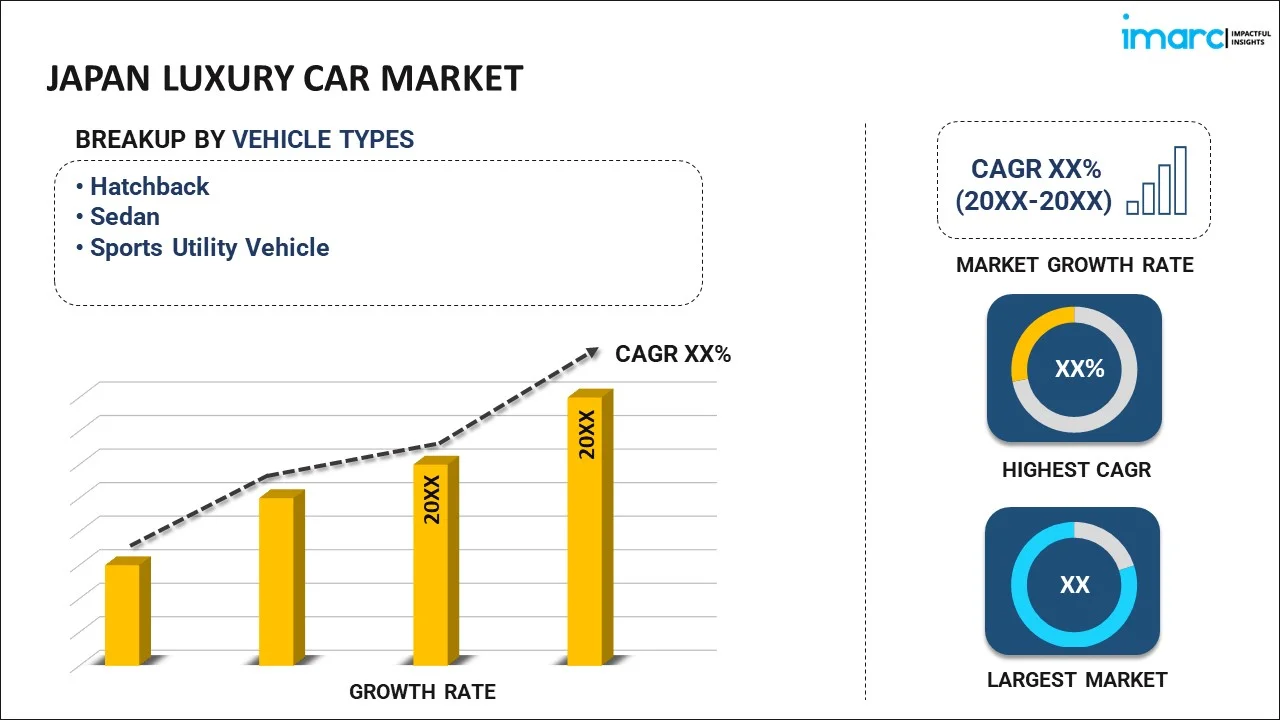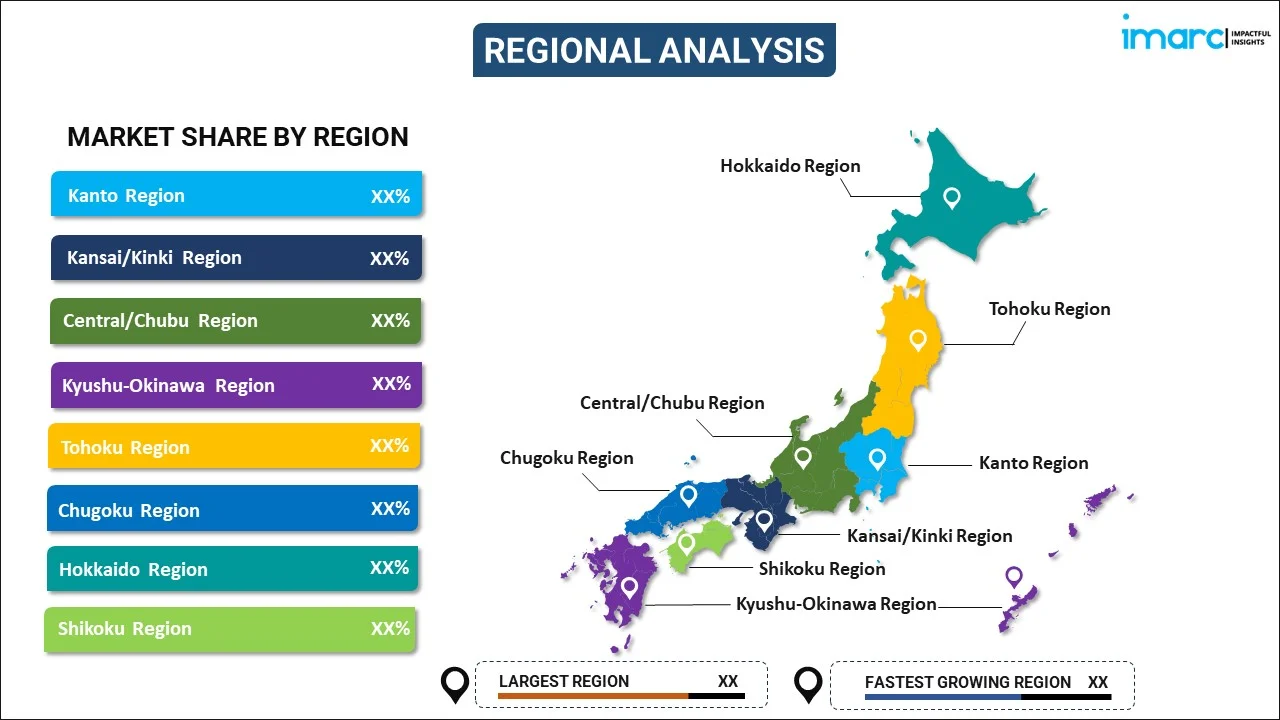
Japan Luxury Car Market Report by Vehicle Type (Hatchback, Sedan, Sports Utility Vehicle), Fuel Type (Gasoline, Diesel, Electric), Price Range (Entry-Level, Mid-Level, High-End, Ultra), and Region 2025-2033
Market Overview:
Japan luxury car market size reached USD 27.7 Billion in 2024. Looking forward, IMARC Group expects the market to reach USD 43.3 Billion by 2033, exhibiting a growth rate (CAGR) of 5.10% during 2025-2033. The market is driven by the availability of advanced vehicle features, increased disposable incomes, growing demand for eco-friendly electric cars, and the popularity of second-hand luxury vehicles, supported by advancements in smart mobility technologies and AI integration.
|
Report Attribute
|
Key Statistics
|
|---|---|
|
Base Year
|
2024 |
|
Forecast Years
|
2025-2033
|
|
Historical Years
|
2019-2024
|
| Market Size in 2024 | USD 27.7 Billion |
| Market Forecast in 2033 | USD 43.3 Billion |
| Market Growth Rate (2025-2033) | 5.10% |
Luxury cars are top-tier, technologically sophisticated automobiles that offer premium interiors, enhanced performance, and a variety of safety features. They provide superior quality, elevated comfort, and innovative services at a higher cost in comparison to economy and mid-sized cars. These vehicles are typically furnished with leather seats, navigation systems, cameras, and upgraded suspension and engines. Additionally, they include features such as anti-kidnapping heartbeat monitors, top speed keys, jump seats, trunk hinges, starlight headliners, gear selectors, pop-up tweeters, and air vent slats, among others. Consequently, luxury cars are gaining significant popularity throughout Japan.
Japan Luxury Car Market Trends:
A notable surge in the availability of upscale features in vehicles, combined with an increase in people's disposable incomes, is causing a shift in consumer preferences toward luxury car brands. This is a key driver behind the expansion of the market. In addition, heightened environmental concerns have led governing bodies and environmental organizations in various countries to strengthen emission regulations. As a result, there is a growing demand for sustainable and environmentally friendly transportation options, such as electric luxury vehicles, worldwide. The market is also being fueled by the growing adoption of second-hand luxury cars, facilitated by easy access to financing, lower initial costs, and annual maintenance agreements. Furthermore, leading manufacturers are introducing advanced smart mobility technologies, including personal voice assistance, autonomous driving, and retina recognition. They are also heavily investing in research and development (R&D) endeavors to incorporate artificial intelligence (AI) and machine learning (ML) technologies, fostering a promising market outlook. In addition, numerous major companies are making significant investments in research and development (R&D) to unveil luxury vehicle models that incorporate advanced smart mobility technologies such as autonomous driving, personalized voice assistance, and retina recognition. They are also releasing vehicles integrated with artificial intelligence (AI) and machine learning (ML) technologies, which is expected to contribute to a favorable market outlook over the forecasted period.
Japan Luxury Car Market Segmentation:
IMARC Group provides an analysis of the key trends in each segment of the market, along with forecasts at the country level for 2025-2033. Our report has categorized the market based on vehicle type, fuel type, and price range.
Vehicle Type Insights:

- Hatchback
- Sedan
- Sports Utility Vehicle
The report has provided a detailed breakup and analysis of the market based on the vehicle type. This includes hatchback, sedan, and sports utility vehicle.
Fuel Type Insights:
- Gasoline
- Diesel
- Electric
A detailed breakup and analysis of the market based on the fuel type have also been provided in the report. This includes gasoline, diesel, and electric.
Price Range Insights:
- Entry-Level
- Mid-Level
- High-End
- Ultra
The report has provided a detailed breakup and analysis of the market based on the price range. This includes entry-level, mid-level, high-end, and ultra.
Regional Insights:

- Kanto Region
- Kansai/Kinki Region
- Central/ Chubu Region
- Kyushu-Okinawa Region
- Tohoku Region
- Chugoku Region
- Hokkaido Region
- Shikoku Region
The report has also provided a comprehensive analysis of all the major regional markets, which include Kanto Region, Kansai/Kinki Region, Central/ Chubu Region, Kyushu-Okinawa Region, Tohoku Region, Chugoku Region, Hokkaido Region, and Shikoku Region.
Competitive Landscape:
The market research report has also provided a comprehensive analysis of the competitive landscape. Competitive analysis such as market structure, key player positioning, top winning strategies, competitive dashboard, and company evaluation quadrant has been covered in the report. Also, detailed profiles of all major companies have been provided.
Japan Luxury Car Market Report Coverage:
| Report Features | Details |
|---|---|
| Base Year of the Analysis | 2024 |
| Historical Period | 2019-2024 |
| Forecast Period | 2025-2033 |
| Units | Billion USD |
| Scope of the Report | Exploration of Historical and Forecast Trends, Industry Catalysts and Challenges, Segment-Wise Historical and Predictive Market Assessment:
|
| Vehicle Types Covered | Hatchback, Sedan, Sports Utility Vehicle |
| Fuel Types Covered | Gasoline, Diesel, Electric |
| Price Ranges Covered | Entry-Level, Mid-Level, High-End, Ultra |
| Regions Covered | Kanto Region, Kansai/Kinki Region, Central/ Chubu Region, Kyushu-Okinawa Region, Tohoku Region, Chugoku Region, Hokkaido Region, Shikoku Region |
| Customization Scope | 10% Free Customization |
| Post-Sale Analyst Support | 10-12 Weeks |
| Delivery Format | PDF and Excel through Email (We can also provide the editable version of the report in PPT/Word format on special request) |
Key Questions Answered in This Report:
- How has the Japan luxury car market performed so far and how will it perform in the coming years?
- What has been the impact of COVID-19 on the Japan luxury car market?
- What is the breakup of the Japan luxury car market on the basis of vehicle type?
- What is the breakup of the Japan luxury car market on the basis of fuel type?
- What is the breakup of the Japan luxury car market on the basis of price range?
- What are the various stages in the value chain of the Japan luxury car market?
- What are the key driving factors and challenges in the Japan luxury car?
- What is the structure of the Japan luxury car market and who are the key players?
- What is the degree of competition in the Japan luxury car market?
Key Benefits for Stakeholders:
- IMARC’s industry report offers a comprehensive quantitative analysis of various market segments, historical and current market trends, market forecasts, and dynamics of the Japan luxury car market from 2019-2033.
- The research report provides the latest information on the market drivers, challenges, and opportunities in the Japan luxury car market.
- Porter's five forces analysis assist stakeholders in assessing the impact of new entrants, competitive rivalry, supplier power, buyer power, and the threat of substitution. It helps stakeholders to analyze the level of competition within the Japan luxury car industry and its attractiveness.
- Competitive landscape allows stakeholders to understand their competitive environment and provides an insight into the current positions of key players in the market.
Need more help?
- Speak to our experienced analysts for insights on the current market scenarios.
- Include additional segments and countries to customize the report as per your requirement.
- Gain an unparalleled competitive advantage in your domain by understanding how to utilize the report and positively impacting your operations and revenue.
- For further assistance, please connect with our analysts.
 Inquire Before Buying
Inquire Before Buying
 Speak to an Analyst
Speak to an Analyst
 Request Brochure
Request Brochure
 Request Customization
Request Customization




.webp)




.webp)












